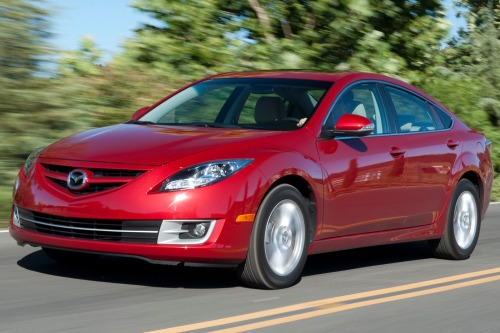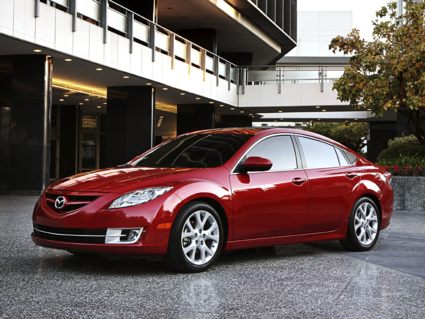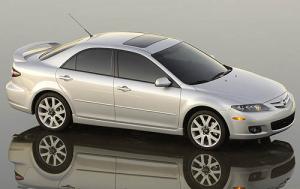In today's very high-priced used car market, many shoppers feel it may be the right time to look at "older" models that have aged well as a way to save significant dollars.

And the Mazda6 is generally one of those models and can definitely be a viable and more economical option at this time, with thorough shopping. And relatively lower mileage candidates can still be found out there.
Most importantly for older vehicles, the Mazda6 has earned an above average reputation for reliability. Of course, this doesn't mean they are all trouble-free. All vehicles have mechanical issues.
And by "older", I'm referring to Mazda6s that are generally 10+ years old, which would mean those from its first and second generations, those produced for the 2003 - 2013 model years.
And a lot of a vehicle's durability also comes down to it being properly cared for, so not all candidates are equal. But history has proven that a well-maintained first generation Mazda6 can last in the 200,000 mile range, while one from the second generation can make it to the 250,000 mile range.
Again, proper maintenance is crucially important.
So here, ...
- We'll list possible mechanical issues for these two Mazda6 generations that owners have reported so they can be checked pre-purchase.
- We'll then do a general overview of each generation, those roughly 10+ years old, which were produced from 2003 - 2013.
- And then we'll wrap things up by summarizing the overall pros and cons of an older Mazda6 worth consideration for potential buyers.
2009 - 2013 Mazda6 Possible Mechanical Problems

The second generation Mazda6 generally improved upon the reliability of its predecessor, but like any vehicle, it still had some mechanical issues reported by owners.
These problems varied in severity and occurrence, and less so than in the first generation, but here are some of the more notable ones, which should therefore be included in an inspection prior to buying:
Transmission Issues: Some owners reported problems with the automatic transmission, including rough shifting, hesitation, or failure to engage gears properly. These issues could be caused by transmission fluid leaks, faulty solenoids, or internal component wear.
Engine Problems: Some models experienced issues such as rough idling, misfiring, or hesitation during acceleration. These problems could be attributed to faulty ignition coils, fuel injectors, or sensor malfunctions.
Electrical Problems: Some owners reported electrical issues, including malfunctioning power windows, door locks, or dashboard warning lights. These problems could stem from faulty switches, wiring issues, or electronic control module failures.
Air Conditioning System: Some owners reported issues with the air conditioning system, such as reduced cooling performance, refrigerant leaks, or compressor failures.
Water Pump Failure: In some cases, the water pump could fail prematurely, leading to overheating issues and potential engine damage if not addressed promptly.
Engine Mounts: There were reports of engine mount failures, which could lead to excessive vibration or noise during operation.
It's important to note that not all Mazda6 vehicles experienced these problems, and the severity of issues could vary depending on factors such as vehicle age, mileage, and maintenance history.
2003 - 2008 Mazda6 Possible Mechanical Problems
The first generation Mazda6, while also generally regarded as a reliable vehicle, had some more common mechanical issues reported by owners. Again, these issues varied in severity and frequency, but should be included in a pre-purchase inspection:
Transmission Issues: Some owners reported problems with the automatic transmission, such as rough shifting, slipping, or failure to engage gears properly. These issues could be attributed to transmission fluid leaks, faulty solenoids, or other internal components.
Engine Problems: Certain models experienced issues with the engine, including rough idling, misfiring, or stalling. These issues could be caused by faulty ignition coils, vacuum leaks, or sensor malfunctions.
Suspension and Steering Components: Some owners reported premature wear and failure of suspension components such as control arms, bushings, and ball joints. Additionally, there were occasional reports of power steering pump failures or leaks, leading to loss of power assistance or steering fluid leaks.
Electrical Problems: Several owners reported electrical issues, including malfunctioning power windows, door locks, or interior lights.
Brake System Concerns: A few owners experienced brake-related issues, such as premature wear of brake pads and rotors, brake fluid leaks, or problems with the anti-lock braking system (ABS).
Air Conditioning System: Some owners reported issues with the air conditioning system, such as reduced cooling performance, refrigerant leaks, or compressor failures.
Second Generation Mazda6 Overview (2009 - 2013)
Offered in sedan form only, powering this version is a choice of two engines: a 2.5-liter four-cylinder that pumps out 170 horsepower and 167 pound-feet of torque, or a 3.7-liter V6 that's good for a hefty 272 horsepower and 269 lb-ft.
The four-cylinder can be found with either a 6-speed manual transmission or a 5-speed automatic. The V6 is 6-speed automatic only.
Other older segment leaders such as the Honda Accord and Toyota Camry don't possess the back twisty road performance dynamics of the Mazda6, while the 6 also matches up well in terms of passenger room, cargo capacity and V6 power.
The i SV model is the value leader and comes with a long list of standard equipment including 16-inch steel wheels, a height-adjustable driver seat, full power accessories, a six-speaker CD stereo system with steering-wheel-mounted controls, air-conditioning, and a tilt/telescoping steering column.
You May Also Like:
Best Time To Buy And How To Negotiate
The i Sport model adds cruise control, an auxiliary input jack and keyless entry as standard features, while the i Touring model adds 17-inch alloy wheels, foglights, keyless ignition/entry, a trip computer, electroluminescent gauges, black patterned accent pieces, a power driver seat, and a leather-wrapped steering wheel and shift knob.
The top-of-the-line i Grand Touring model adds xenon headlights, heated leather seats with a memory function for the driver seat, dual-zone automatic climate control, auto-dimming mirrors, Bluetooth connectivity, and an auditory blind-spot monitoring system.
The s models have the same standard equipment, but also add a few others: the s Sport comes with 17-inch alloy wheels and dual exhaust, while the s Touring and s Grand Touring chip in 18-inch alloy wheels.
Some older Mazda6 models can also be found with optional features such as an in-dash 6-disc CD changer, satellite radio, a sunroof, and navigation.
Overall positives for this production run include capable handling, attractive design, increased passenger room, and much improved V6 performance.
On the downside, while the V6 is powerful, its fuel economy is a bit underwhelming (17 mpg city, 25 highway; the four-cylinder models can get 20 mpg city and 30 mpg highway. In addition, while the cabin was improved, some cheaper plastics still remain.
First Generation Mazda6 Overview (2003 - 2008)

This version jumped right into the extremely competitive midsize car segment ... one dominated by hall of fame models such as the Honda Accord and Toyota Camry. But no problem, the Mazda6 fared extremely well due to its impressive performance, handling, and good looks ... both interior and exterior.
And we're not the only ones who feel this way. In fact, these older Mazda6 models won rave reviews for its stylish design, handsomely equipped interior, precise steering, responsive suspension, and athletic 4-cylinder and V6 engines.
Also setting this versatile midsize apart was the fact that it came in three very distinct body styles. Yes, for those who need space, these 6s are also available as a 4-door hatchback or a wagon.
Each model had two trim levels: the i and the s. The i was powered by a zesty 4-cylinder, 160-horsepower engine with either a 5-speed manual transmission or a 5-speed automatic. The s was equipped with a 215-horsepower V6 with either the manual or 6-speed automatic transmission.
Various models that meet most individual needs include the Sport, Grand Touring, and Grand Sport. And for those seeking a high-performance vehicle, there's the MAZDASPEED 6 ... with a gutzy 278-horsepower, turbocharged, 4-cylinder engine that's coupled to all-wheel drive and a 6-speed manual transmission.
Even the base 6 models were well-equipped, with standard features that include full power accessories, cruise control, and better grade cloth upholstery.
Moving up in models adds additional features such as leather upholstery, foglights, a power sunroof, a rear spoiler, and an upgraded stereo system with a CD changer.
Overall, this version offers a stylish design, firm suspension, responsive handling, and versatile body style choices as the four-door hatchback and wagon are not only fun-to-drive, but also offer abundant storage capacities.
On the downside, these models are obviously older, with more wear and tear likely, and a bit less reliable than the next generation. They also have a somewhat lower quality interior, passenger room that's on the tighter side, and a V6 that's a bit underpowered when compared to more uplevel competitors.
Even so, when found with lower miles and very well-cared for, this generation can still be a good choice for those seeking a livelier family sedan or more practicality from the wagon or hatchback models instead of an SUV.
Overall Pros And Cons Of An Older Mazda6
Older Mazda6 Pros
Affordability: Clearly, older Mazda6 models are likely to be more affordable options compared to newer cars, offering potentially significant savings in upfront costs.
Reliability Potential: While they may have had some common mechanical issues, Mazda6 models from both generations have generally been considered reliable vehicles. Found with lower mileage, and with proper maintenance and care, they can still offer dependable transportation for many years.
Decent Features: Despite being older models, the Mazda6 still offers decent features, especially in higher trim levels. This might include amenities like leather upholstery, premium audio systems, and advanced safety features, depending on the specific model and trim level.
Attractive Design: The Mazda6 has a sleek and sporty design, drawing attention with its modern styling cues.
Engaging Driving Experience: It's known for its agile handling and responsive steering, providing an enjoyable driving experience.
Good Fuel Efficiency: Offers competitive fuel efficiency, especially with its four-cylinder engine options.
Roomy Interior: Provides a spacious cabin with ample legroom and headroom for both front and rear passengers.
Improved Interior Quality: In the second generation, there were significant improvements in interior quality and overall fit and finish.
Safety Features: The second generation also added more advanced safety features like stability control and options such as blind-spot monitoring.
Older Mazda6 Cons
Potentially Higher Maintenance Costs: While older models can be more affordable upfront, they may require more frequent maintenance and repairs due to age and mileage, potentially offsetting some or all of the initial savings.
Aging Design and Technology: The design and technology of the first and second generation Mazda6 models may feel outdated to some buyers, especially those accustomed to the latest features and styling trends found in newer vehicles.
Limited Safety Features: While both generations of the Mazda6 offer basic safety features, such as airbags and antilock brakes, they may lack some of the advanced driver assistance systems found in newer cars, such as adaptive cruise control, lane departure warning, and automatic emergency braking.
Limited Power: Some found the power output lacking, particularly compared to rivals with V6 options.
Interior Quality: Materials and build quality were sometimes criticized for being less refined compared to competitors, particularly in the first generation.
Ride Comfort: Some owners found the suspension setup could result in a firmer ride quality, especially on rough roads.
Limited Cargo Space: Trunk space was somewhat smaller compared to competitors, limiting practicality for some users.
Tight Rear Headroom: The limited rear headroom can be uncomfortable for taller passengers.
Road Noise: Despite improvements in the second generation, some found road noise could still be an issue.
 By Josh Rosenberg
By Josh Rosenberg